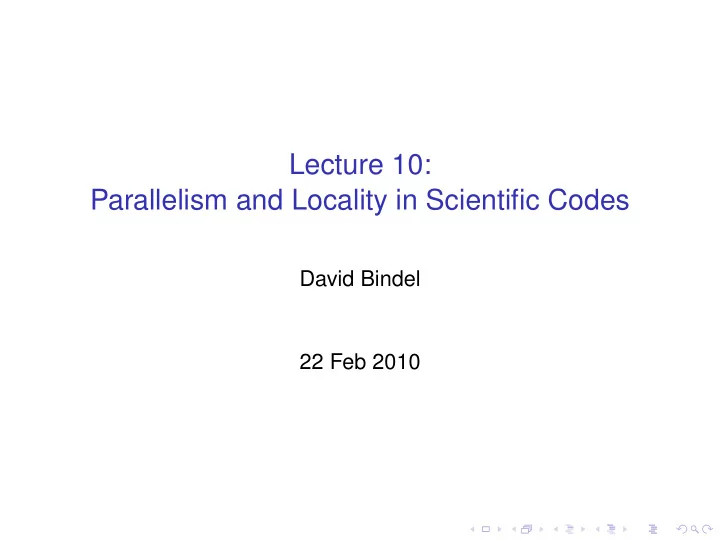

Lecture 10: Parallelism and Locality in Scientific Codes David Bindel 22 Feb 2010
Logistics ◮ HW 2 posted – due March 10. ◮ Groups of 1–3; use the wiki to coordinate. ◮ Thinking about projects: ◮ Small teams (2–3, 1 by special dispensation) ◮ Understanding performance, tuning, scaling is key ◮ Feel free to leverage research, other classes (with approval)! ◮ Want something high quality... but also something you can finish this semester! ◮ Ideas...
HW 2 discussion (On board / screen)
HW 2 1. Time the baseline code. ◮ How does the timing scale with the number of particles? ◮ How does the timing scale with the number of processors? ◮ How well is the serial code performing? 2. Use spatial decomposition to accelerate the code. ◮ Example: bin sort the particles into grid squares and only compare neighboring bins (could also do other spatial data structures, neighbor lists, etc) ◮ What speedup do you see vs the original code? ◮ How does the scaling change in the revised code? ◮ What should the communication change? 3. Time permitting: do some fun extension! ◮ Is the code “right”? What are the numerical properties? ◮ Can you improve the time integration? ◮ Can you further tune the inner loops (e.g. with SSE)?
Basic styles of simulation ◮ Discrete event systems (continuous or discrete time) ◮ Game of life, logic-level circuit simulation ◮ Network simulation ◮ Particle systems (our homework) ◮ Billiards, electrons, galaxies, ... ◮ Ants, cars, ...? ◮ Lumped parameter models (ODEs) ◮ Circuits (SPICE), structures, chemical kinetics ◮ Distributed parameter models (PDEs / integral equations) ◮ Heat, elasticity, electrostatics, ... Often more than one type of simulation appropriate. Sometimes more than one at a time!
Common ideas / issues ◮ Load balancing ◮ Imbalance may be from lack of parallelism, poor distributin ◮ Can be static or dynamic ◮ Locality ◮ Want big blocks with low surface-to-volume ratio ◮ Minimizes communication / computation ratio ◮ Can generalize ideas to graph setting ◮ Tensions and tradeoffs ◮ Irregular spatial decompositions for load balance at the cost of complexity, maybe extra communication ◮ Particle-mesh methods — can’t manage moving particles and fixed meshes simultaneously without communicating
Lumped parameter simulations Examples include: ◮ SPICE-level circuit simulation ◮ nodal voltages vs. voltage distributions ◮ Structural simulation ◮ beam end displacements vs. continuum field ◮ Chemical concentrations in stirred tank reactor ◮ concentrations in tank vs. spatially varying concentrations Typically involves ordinary differential equations (ODEs), or with constraints (differential-algebraic equations, or DAEs). Often (not always) sparse .
Sparsity * * 1 2 3 4 5 * * * A = * * * * * * * * Consider system of ODEs x ′ = f ( x ) (special case: f ( x ) = Ax ) ◮ Dependency graph has edge ( i , j ) if f j depends on x i ◮ Sparsity means each f j depends on only a few x i ◮ Often arises from physical or logical locality ◮ Corresponds to A being a sparse matrix (mostly zeros)
Sparsity and partitioning * * 1 2 3 4 5 * * * A = * * * * * * * * Want to partition sparse graphs so that ◮ Subgraphs are same size (load balance) ◮ Cut size is minimal (minimize communication) We’ll talk more about this later.
Types of analysis Consider x ′ = f ( x ) (special case: f ( x ) = Ax + b ). Might want: ◮ Static analysis ( f ( x ∗ ) = 0) ◮ Boils down to Ax = b (e.g. for Newton-like steps) ◮ Can solve directly or iteratively ◮ Sparsity matters a lot! ◮ Dynamic analysis (compute x ( t ) for many values of t ) ◮ Involves time stepping (explicit or implicit) ◮ Implicit methods involve linear/nonlinear solves ◮ Need to understand stiffness and stability issues ◮ Modal analysis (compute eigenvalues of A or f ′ ( x ∗ ) )
Explicit time stepping ◮ Example: forward Euler ◮ Next step depends only on earlier steps ◮ Simple algorithms ◮ May have stability/stiffness issues
Implicit time stepping ◮ Example: backward Euler ◮ Next step depends on itself and on earlier steps ◮ Algorithms involve solves — complication, communication! ◮ Larger time steps, each step costs more
A common kernel In all these analyses, spend lots of time in sparse matvec: ◮ Iterative linear solvers: repeated sparse matvec ◮ Iterative eigensolvers: repeated sparse matvec ◮ Explicit time marching: matvecs at each step ◮ Implicit time marching: iterative solves (involving matvecs) We need to figure out how to make matvec fast!
Recommend
More recommend